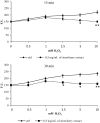Polyphenol-rich strawberry extract protects human dermal fibroblasts against hydrogen peroxide oxidative damage and improves mitochondrial functionality
- PMID: 24962387
- PMCID: PMC6270910
- DOI: 10.3390/molecules19067798
Polyphenol-rich strawberry extract protects human dermal fibroblasts against hydrogen peroxide oxidative damage and improves mitochondrial functionality
Abstract
Strawberry bioactive compounds are widely known to be powerful antioxidants. In this study, the antioxidant and anti-aging activities of a polyphenol-rich strawberry extract were evaluated using human dermal fibroblasts exposed to H2O2. Firstly, the phenol and flavonoid contents of strawberry extract were studied, as well as the antioxidant capacity. HPLC-DAD analysis was performed to determine the vitamin C and β-carotene concentration, while HPLC-DAD/ESI-MS analysis was used for anthocyanin identification. Strawberry extract presented a high antioxidant capacity, and a relevant concentration of vitamins and phenolics. Pelargonidin- and cyanidin-glycosides were the most representative anthocyanin components of the fruits. Fibroblasts incubated with strawberry extract and stressed with H2O2 showed an increase in cell viability, a smaller intracellular amount of ROS, and a reduction of membrane lipid peroxidation and DNA damage. Strawberry extract was also able to improve mitochondrial functionality, increasing the basal respiration of mitochondria and to promote a regenerative capacity of cells after exposure to pro-oxidant stimuli. These findings confirm that strawberries possess antioxidant properties and provide new insights into the beneficial role of strawberry bioactive compounds on protecting skin from oxidative stress and aging.
Conflict of interest statement
The authors declare no conflict of interest.
Figures







Similar articles
-
An anthocyanin-rich strawberry extract protects against oxidative stress damage and improves mitochondrial functionality in human dermal fibroblasts exposed to an oxidizing agent.Food Funct. 2014 Aug;5(8):1939-48. doi: 10.1039/c4fo00048j. Food Funct. 2014. PMID: 24956972
-
The protective effect of acerola (Malpighia emarginata) against oxidative damage in human dermal fibroblasts through the improvement of antioxidant enzyme activity and mitochondrial functionality.Food Funct. 2017 Sep 20;8(9):3250-3258. doi: 10.1039/c7fo00859g. Food Funct. 2017. PMID: 28815233
-
Strawberry polyphenols attenuate ethanol-induced gastric lesions in rats by activation of antioxidant enzymes and attenuation of MDA increase.PLoS One. 2011;6(10):e25878. doi: 10.1371/journal.pone.0025878. Epub 2011 Oct 7. PLoS One. 2011. PMID: 22016781 Free PMC article.
-
Photoprotective potential of strawberry (Fragaria × ananassa) extract against UV-A irradiation damage on human fibroblasts.J Agric Food Chem. 2012 Mar 7;60(9):2322-7. doi: 10.1021/jf205065x. Epub 2012 Feb 22. J Agric Food Chem. 2012. PMID: 22304566
-
Anti-oxidant effects of the extracts from the leaves of Chromolaena odorata on human dermal fibroblasts and epidermal keratinocytes against hydrogen peroxide and hypoxanthine-xanthine oxidase induced damage.Burns. 2001 Jun;27(4):319-27. doi: 10.1016/s0305-4179(00)00137-6. Burns. 2001. PMID: 11348739
Cited by
-
Gut-Skin Axis: Current Knowledge of the Interrelationship between Microbial Dysbiosis and Skin Conditions.Microorganisms. 2021 Feb 11;9(2):353. doi: 10.3390/microorganisms9020353. Microorganisms. 2021. PMID: 33670115 Free PMC article. Review.
-
Effect of A Polyphenol-Rich Canarium album Extract on the Composition of the Gut Microbiota of Mice Fed a High-Fat Diet.Molecules. 2018 Aug 30;23(9):2188. doi: 10.3390/molecules23092188. Molecules. 2018. PMID: 30200213 Free PMC article.
-
Bioactive Ingredients with Health-Promoting Properties of Strawberry Fruit (Fragaria x ananassa Duchesne).Molecules. 2023 Mar 17;28(6):2711. doi: 10.3390/molecules28062711. Molecules. 2023. PMID: 36985683 Free PMC article. Review.
-
Effect of Procyanidin-rich Extract from Natural Cocoa Powder on Cellular Viability, Cell Cycle Progression, and Chemoresistance in Human Epithelial Ovarian Carcinoma Cell Lines.Pharmacogn Mag. 2016 May;12(Suppl 2):S109-15. doi: 10.4103/0973-1296.182164. Epub 2016 May 11. Pharmacogn Mag. 2016. PMID: 27279694 Free PMC article.
-
The Protective Effect of Carotenoids, Polyphenols, and Estradiol on Dermal Fibroblasts under Oxidative Stress.Antioxidants (Basel). 2021 Dec 20;10(12):2023. doi: 10.3390/antiox10122023. Antioxidants (Basel). 2021. PMID: 34943127 Free PMC article.
References
-
- Giampieri F., Alvarez-Suarez J.M., Tulipani S., Gonzalez-Paramas A.M., Santos-Buelga C., Bompadre S., Quiles J.L., Mezzetti B., Battino M. Photoprotective potential of strawberry (Fragaria × ananassa) extract against UV-A irradiation damage on human fibroblasts. J. Agric. Food Chem. 2012;60:2322–2327. doi: 10.1021/jf205065x. - DOI - PubMed
MeSH terms
Substances
LinkOut - more resources
Full Text Sources
Other Literature Sources

